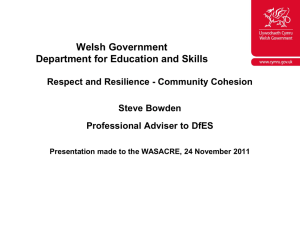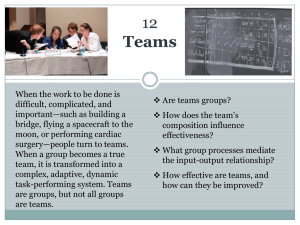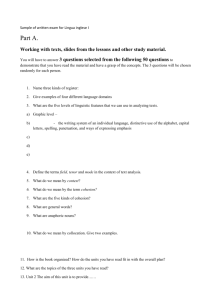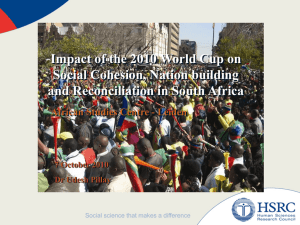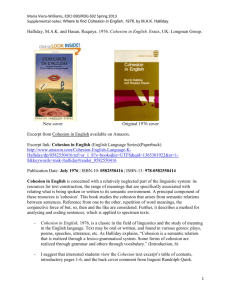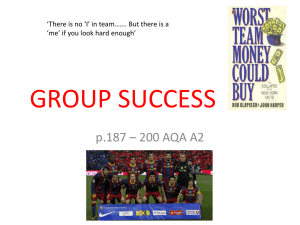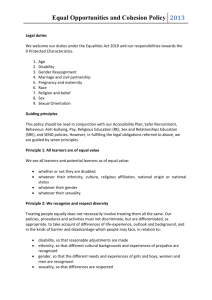Policies that promote social cohesion
advertisement
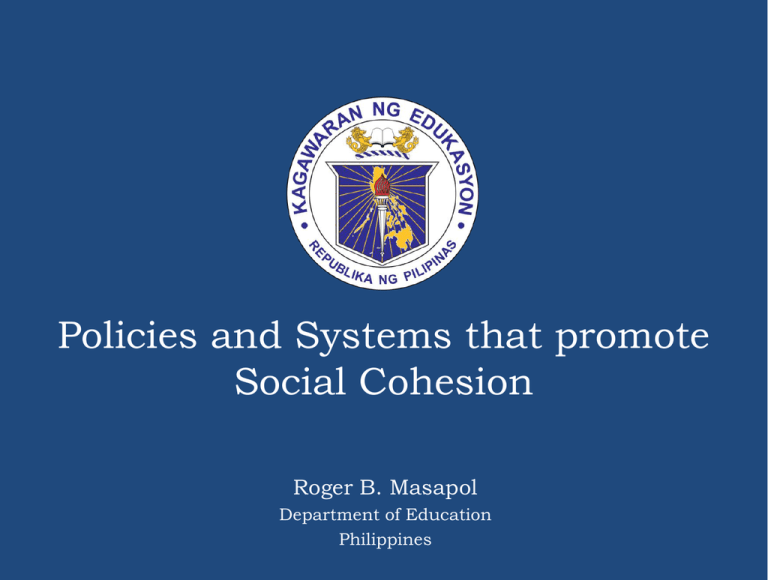
Policies and Systems that promote Social Cohesion Roger B. Masapol Department of Education Philippines Outline 1. 2. 3. 4. Philippine Education System Education Performance Social Cohesion defined PH Laws, policies and programs that promote social cohesion 5. The K to 12 Curriculum Framework 6. Advocacies and Campaigns DEPARTMENT OF EDUCATION 2 Philippine Education System Age 5 Age 6-11 DEPARTMENT OF EDUCATION Age 12-15 Age 16-17 3 Basic Education Performance 2010 BASELINE 2016 TARGETS NER CSR CR NAT • Girls consistently outperform boys in all performance indicators • Targets for elementary enrolment rate is likely to be achieved • High proportion of secondary learners are completing the cycle than elementary learners OPS-PPD DEPARTMENT OF EDUCATION Social Cohesion defined wellbeing of all its members, fights exclusion and marginalization, creates a sense of belonging, promotes trust, and offers its members the opportunity of upward mobility. A cohesive society works towards the Source: OECD DEPARTMENT OF EDUCATION 5 Components of Social Cohesion Social Inclusion Social Capital Social Cohesion Social Mobility Source: OECD DEPARTMENT OF EDUCATION 6 DepEd: a Cohesive Organization • We dream of Filipinos who passionately love their values and competencies enable them to realize their full potential and contribute meaningfully to building Vision the nation. • As a learner-centered public country and whose institution, the Department of Education better serve it stakeholders. continuously improves itself to DEPARTMENT OF EDUCATION 7 Well defined roles and responsibilities Mission: “To protect and promote the right of every Filipino to quality, equitable, culture-based, and complete basic education: Key Players Role Responsiblities Students Rights Holder Teachers Duty Bearer Facilitate learning and constantly nurture every learner Duty Bearer As stewards of the institution, ensure an enabling and supportive environment for effective learning to happen Administrators and staff Family, community, and other stakeholders Learn in a child-friendly, gender-sensitive, safe, and motivating environment Duty Bearer Are actively engaged and share responsibility for developing life-long learners DEPARTMENT OF EDUCATION 8 DepEd: a Cohesive Organization • Makadiyos [for God] Core • Makatao [for People] Values • Makalikasan [for Environment] • Makabansa [for Country] 9 DEPARTMENT OF EDUCATION PH Laws that promote Social Cohesion Improving Access to Education • Free Public Secondary Education Act., 1988 • Government Assistance to Students and Teachers in Private Education (GASTPE) Act, 1989 • The Magna Carta for Disabled Persons, 1992 • The Indigenous Peoples’ Rights Act of 1997 • An Act Providing for the Magna Carta of Women, 2008 Improving Quality of Education • Kindergarten Education Act, 2012 • Early Years Act of 2013 • Enhanced Basic Education Act of 2013 Improving Education Governance • Education Act of 1982 • An Act Providing for an Organic Act for the ARMM, 1989 • Governance of Basic Education Act of 2001 DEPARTMENT OF EDUCATION 10 Policies that promote Social Cohesion Grassroots Participatory Budgeting (GPB) To make the National Budget more Responsive To encourage Local Governments to implement Reforms DEPARTMENT OF EDUCATION To deepen democracy and empower Citizens Policies that promote Social Cohesion Civil Society Participation in the Budget Process Benefits: Transparency Full Disclosure Accountability Responsive Budget Minimized Fraud Ownership of Outcomes by the community DEPARTMENT OF EDUCATION Policies and practices that promote Social Cohesion Public-Private Partnership (PPP) Strategy Report Card Information Systems 13 DEPARTMENT OF EDUCATION Education Policies that promote social cohesion Non-requirement of Wearing School Uniforms No Collection Policy Free Exercise of Religion Gender and Development (GAD) DEPARTMENT OF EDUCATION 14 Child Protection Policy BULLYING refers to willful aggressive behavior that is directed, towards a particular victim who may be outnumbered, younger, weak, with disability, less confident, or otherwise vulnerable. THREATS STALKING TAKING OF PROPERTY PUBLIC HUMILIATION DAMAGE OF PROPERTY PHYSICAL VIOLENCE DEMANDING SEXUAL OR MONETARY FAVORS RESTRAINING THE LIBERTY OR FREEDOM OF A PUPIL OR STUDENT DEPARTMENT OF EDUCATION 15 Mother Tongue-Based Multilingual Education (MTB-MLE) In Kinder to Grade 3, the child’s dominant language is used as the language of learning. Filipino and English language proficiency is developed from Kinder to Grade 3 but very gradually. Mother Tongue is used in instruction and learning materials of other learning areas. The learners retain their ethnic identity, culture, heritage and values. Children learn better and are more active in class and learn a second language even faster when they are first taught in a language they understand. DEPARTMENT OF EDUCATION Mother Tongue-Based Multilingual Education (MTB-MLE) Bridging Framework A multi-literate Filipino learner Literate in L1 and L2 Literate in L1 English Filipino Mother Tongue DEPARTMENT OF EDUCATION Mother-Tongue-Based Multilingual Education DEPARTMENT OF EDUCATION 18 Access to Secondary Education Muslim Education Indigenous Peoples Education 1.16 Million Learners 1.19 Million Learners DEPARTMENT OF EDUCATION 19 Access to Secondary Education Special Education Program Open High School 349 High Schools 980 schools Alternative Delivery Modes 75,233 learners “Abot-Alam” Program 1.2 Million OSYs mapped DEPARTMENT OF EDUCATION 20 The K to 12 Basic Education Curriculum Framework The K to 12 Philippine Basic Education Curriculum Framework CONTEXT PHILOSOPHICAL & LEGAL BASES NATURE OF THE LEARNER NEEDS OF NATIONAL & GLOBAL COMMUNITY RA 10533 Enhanced Basic Education Act of 2013 Kindergarten Act The 1987 Phil. Constitution BP 232, Education Act of 1982 RA 9155, Governance of Basic Education Act of 2001 The vision, mission statements of DepEd SOUTELE, 1976 The EDCOM Report of 1991 Basic Education Sector Reform Agenda (BESRA) The four pillars of education (UNESCO) Has a body and spirit, intellect, free will, emotions, multiple intelligence, learning styles Constructor of knowledge and active maker of meaning, not a passive recipient of information Poverty reduction and human development Strengthening the moral fiber of the Filipino people Development of a strong sense of nationalism Development of productive citizens who contribute to the building of a progressive, just, and humane society Ensuring environmental sustainability Global partnership for development NEEDS OF THE LEARNER Life skills Self-actualization Preparation for the world of the work, entrepreneurship, higher education DEPARTMENT OF EDUCATION K to 12 Curriculum Structure Elementary Junior High School Kinder to Grade 6 Grades 7 to 8 (Exploratory TLE) Grades 9 to 10 (Specialized TLE) Tracks Contextualized Track Subjects Senior High School Academic Track Core Subjects o General Academic Strand o STEM o ABM o HUMSS Technical Vocational Livelihood Track o Home Economics o AgriFishery o Industrial Arts o ICT DEPARTMENT OF EDUCATION Sports Track Arts & Design Track Features of the K to 12 Curriculum learner-centered, inclusive, and researchbased standards- and competence-based, seamless, decongested culture-responsive and culture-sensitive, integrative and contextualized, relevant and responsive flexible, ICT-based, and global DEPARTMENT OF EDUCATION Philippine Qualifications Framework DEPARTMENT OF EDUCATION Contextualization and Localization “The curriculum shall be contextualized and global;” “The curriculum shall be flexible enough to enable and allow schools to localize, indigenize and enhance the [curriculum] based on their respective educational and social contexts.” ‒Sec. 10.2 (d) and (h) RA 10533 Implementing Rules and Regulations DEPARTMENT OF EDUCATION Advocacies and Campaigns DEPARTMENT OF EDUCATION 27 Thank you


